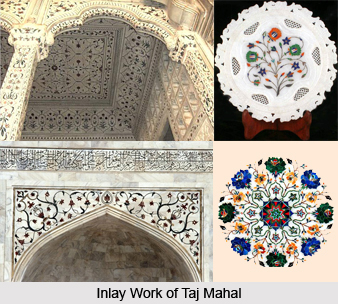 Inlay Work of Agra is one of the famous handicrafts of India. This ancient creative skill has been introduced by the Mughals. Inlay basically is an ornamental technique of fitting in pieces of contrasting (sometimes coloured) materials into depressions in a base object to obtain patterns or pictures that normally are flush with the matrix.
Inlay Work of Agra is one of the famous handicrafts of India. This ancient creative skill has been introduced by the Mughals. Inlay basically is an ornamental technique of fitting in pieces of contrasting (sometimes coloured) materials into depressions in a base object to obtain patterns or pictures that normally are flush with the matrix.
The mosaic work of Agra is an inlay of crystal, topaz, pearls, turquoise, carnelian, jade, coral, amethyst, blood-stone, carbuncle, sapphire, jasper, lapis-lazuli, garnets, and agates. Chalcedony on white marble is also applied to ornamental furniture and household objects. This originated in the exquisite decorations of the Taj Mahal at Agra. Taj Mahal was built by Mughal emperor Shah Jahan in memory of his third wife, Mumtaz Mahal. It is Florentine in origin and style. However, the designs have a local character of their own and adhere strictly to the principles and methods of Indian ornamentation.
The palace of Akbar at Agra is of red sandstone. However, the whole of its corridors, chambers and pavilions are made of polished white marble, wrought with mosaics and carvings. Small pieces of wood of suitable geometrical forms are cut out and inlaid with bits of looking-glass painted and gilded separately.
Mosaic work originated in pavement and the introduction of ornamental pavement was inspired by Oriental tapestry. The paved floors of rooms and passages were designated pavimenta subtegulanea. Pavements in the open air especially those laid on the flat roofs of houses are called pavimenta subdialia. The pavimentum sectik was composed of different-coloured marbles cut into regular forms like the cells of a honeycomb. The pavimentum tessellatum was a sectile pavement, composed of large tessera Vermicular mosaic was divided into cus majus, opus medium and znd opus. The use of inlaid stone in mosaic work by the Mughals in India was due to the revival of the ancient art in Italy. The Italians developed two distinct forms of inlaying in stone: the Roman mosaic of modern jewellers and the Florentine. The Florentine form of mosaic was used in the decoration of Taj-Mahal and has become naturalised as a local art at Agra.






